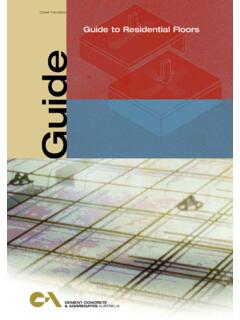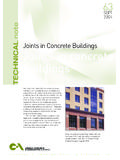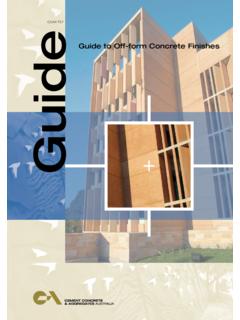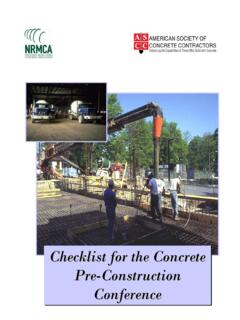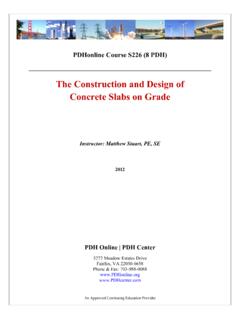Transcription of Y 2018
1 TOLERANCES for Concrete SurfacesINTRODUCTION Tolerances are provided to ensure the finished concrete surface is acceptable for the application and the intended function. Setting tolerances also demonstrate that some degree of variation is inherent in all building work. The position of the concrete element, its function, appearance and the influence of these on the total project would, in many cases, define the appropriate tolerances. On the other hand, tolerances must also be reasonable, both achievable and able to be checked in the field using the available techniques and at acceptable cost. The importance of specifying appropriate tolerances becomes apparent when the outcome fails to meet the original expectations. Some Australian Standards specify tolerances for concrete surfaces and it is important to understand their relevance or limitation for particular applications.
2 This Datasheet reviews the tolerance requirements in various codes and standards, provides guidance on appropriate tolerances (particularly for unformed surfaces) and discusses the issues involved in achieving the specified tolerances. DEFINITIONS Formed Surface: A Surface requiring formwork to provide shape and texture/finish to the concrete. Unformed Surface: A surface that does not require formwork to provide either shape or finish to the surface, the top surface of slabs or pavements. These surfaces generally have to meet two independent tolerance criteria: the flatness of the surface and variation from the designed elevation ( levelness ). flatness : The deviation of the surface from a straight line joining two points on the surface. levelness (elevation tolerance): The permitted vertical variation of the surface from a fixed external reference point or datum. Assessing Tolerances: It should be noted that measurement for assessment of as-constructed tolerances must be made within 24 hours to 72 hours of construction.
3 The reason for this is that factors, outside of the construction process may influence measurements made outside of this time period ( release of propping on suspended slabs and beams, ground movement under slabs cast on ground, shrinkage and curling effects etc.). In the case of columns and walls, measurement should take place as soon as is possible after formwork removal. MEASURING TOLERANCES As the specification of tolerances is dependent on the method of measurement, this is usually determined first. While the two common methods used in Australia are the optical and straightedge, methods include: Optical Optical survey instruments can be used to measure the levelness , flatness , position or plumb of an element. For pavement or slab levelness and flatness , spot checks on a grid TOLERANCS can be defined as the allowable variations from the specified values or performance levels.
4 2018 J U L Y PAGE 2 OF 10 > TOLERANCES FOR CONCRETE SURFACES pattern are often made. If relying entirely on spot measurements, the grid size may be quite small, say Combined with a straightedge, readings may be taken on, say, a 3m grid, with a straightedge used to check the variation between measured points. Instruments can have an accuracy of , and computer topographical maps drawn indicating slab contours to assist with the evaluation. Since small grid sizes may be required, the cost of this method should be evaluated, particularly when used over large areas. Straightedge Tolerances can be determined by placing a straightedge anywhere on a concrete surface in any direction and measuring the maximum deviation of the surface from the straightedge (see Figure 1). The use of a 3m straightedge has been found to be a simple and generally satisfactory method of measurement in Australia.
5 A shorter length ( to 15m) straightedge is one of the methods for measuring surface tolerances of formed concrete prescribed by AS The variation from the straightedge is typically expressed as a maximum deviation value over the straightedge length but can be assessed by the method provided in ACI 1174. Figure 1: testing the surface for compliance using a straightedge. While the 3m straightedge technique is simple, inexpensive and widely used, one of the deficiencies of the method includes the difficulty in testing large pavement areas. Other deficiencies include inability to reproduce test results and failure of the method to assess the acceptability of irregularities such as steps and surface undulations (often referred to as waviness see Figure 2). The length of the undulations in an unformed slab surface is an important consideration when choosing the length of a straight edge.
6 Shorter (300mm and1500mm) straightedges as specified in AS for formed surfaces could be used provided the length of the straightedge exceeds the maximum length of undulations. It is common for the length of undulations n the unformed surface of slabs to vary from 600mm to 3m, so care should be taken when selecting a straightedge less than 3m for this assessment (see Figure 2). Figure 2: 3m straightedge tolerances fail to assess surface undulations (waviness). A better method of using a 3m straightedge and assessing its resulting test data is provided in ACI 1174. This standard recognises the difficulties is assessing straightedge data and recommends that two limits are applied for flatness tolerance. These are based on a standard approach to measuring the slab surface and the proposed deviation limits that are the limit at which 90% of the test measurements are less than and also the limit which 100% of the test measurements are less than.
7 This approach to assessment is reflected in Table 1 overleaf, and used here to compare straightedge data with that from instruments used to measure flatness numbers and levelness numbers. String-lines String-lines re suitable for assessing large elements but should be used only in still air conditions. They are more suited to vertical surfaces, as the deflection or sag over long distances could introduce errs for horizontal surfaces. They are typically held away from the surface on suitable spacers to ensure the string-line is straight and the deviation of the surface from the string-line can be measured. F-Meter and Dipstick Instruments The F-Meter and Dipstick instruments were developed by the Face Company in the United States. These instruments are used to assess the flatness and levelness of floors by measuring the Face floor -profile numbers, call F-numbers. The flatness F-number (FF) is related to the maximum allowable floor PAGE 3 OF 10 > TOLERANCES FOR CONCRETE SURFACES curvature over 600mm computed on the basis of successive 30mm elevations differentials2.
8 The levelness F-number (FL) is related to the relative conformity of the surface to a horizontal plane as measured over a 3m length. Generally, the two F-numbers are expressed as FF and FL. Further information on this measuring system can be found in ACI and ASTM E1155M2. Large areas can be assessed easily for compliance using this method, as the instrument can be quickly moved across the surface (see Figure 3). It is important that measurements are taken as soon as possible, since subsequent procedures, such as saw cutting joints, will affect results. These instruments are available in Australia but their use is still relatively rare with the Dipstick instrument more commonly used. To allow a contractor to assess the work (and cost) involved in delivering the required finish, a correlation between the F-numbers and an existing familiar method such as the straightedge may initially be required.
9 While these is no direct equivalence between F-numbers and 3m straightedge tolerances, Table 1 gives an approximate correlation between the two systems assess by the method of ACI 1174. Figure 3: F-Meter Profilograph This instrument is a variation of the F-Meter and was developed by the Australian Road Research Board Transport Research (ARRB TR). It is a height-measuring device for checking the longitudinal profile of both new and existing road pavements. Table 1: Approximate correlation between F-numbers and straightedge tolerances (after ACI 1174) *Refers to a finishing process in which a long straightedge (3m to 4m) is drawn across the surface transverse to the direction of screeding to remove undulations in the transverse direction. STANDARDS AND SPECIFICATIONS When specifying tolerances for concrete work, reference is often made to the Australian Standards/Specifications AS , AS 36005 and NATSPEC6.
10 The relevant contents of these are outlined below. AS Formwork for concrete This Standard deals with the visual quality (appearance) of formed concrete surfaces, for both in-situ and precast concrete elements. The surface finish quality is specified as one of five classes. Classes 1, 2 and 3 are typical architectural applications where the concrete surface visual quality is important. Tolerances for each class are specified for various aspects of the surface finish (see Table 2). If concrete elements have non-critical faces and/or some of the surface finish tolerances are less important, these can relaxed and are designated by the suffix X after the class of finish, ( Class 2X). The limits of any less stringent tolerances should be include in the project documentation but should not be less stringent than the tolerances given in AS 36005 for structural adequacy. Classes 4 and 5 3m Straightedge Tolerance (90% less than 100% less than) floor profile quality FF FL (mm) Conventional Surface Bull-floated 15 13 16 - 23 Straight-edged* 20 15 13 - 19 Flat 25 20 10 - 16 Very flat 50 30 3 - 7 Super flat 100 50-100 2 - 3 Typical warehouse 25-35 6 - 12 PAGE 4 OF 10 > TOLERANCES FOR CONCRETE SURFACES are for typical structural applications where the concrete surface is either not visible, or the surface finish quality is no critical ( footings, concrete frames covered by other finishes).
